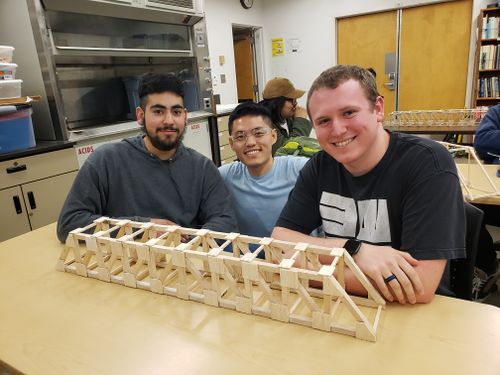
Background
As a part of the Engineering 210 course at Humboldt State University, students were tasked to work in groups of 3 or 4 to build a truss bridge out of balsa wood and super glue. Our group included David Topete, Kong Vang, and Andrew Kizer (listed left to right in Figure 1) and we are the KAD Group. This page is designed to showcase the bridge we built including the design, how it was made, and how it performed.
Project goals
The class project had specific requirements and parameters that each bridge must follow for both design and building:
- The bridge must span 36 in and rest between 2 surfaces with a 1/2 overlay on either side.
- The bridge must have a minimum height of 4 in
- The bridge must have a minimum width of 4 in
- The bridge must support a minimum weight of 24 lbs
- The bridge must be made of balsa wood and super glue only.
Prototyping
Our design was modeled after a typical Howe Bridge design utilizing right triangles that mirrored over the center. However, prototyping of this design was required to understand the best way to build the bridge and utilize our resources most efficiently.

Our first prototype was made of plastic members, small plastic plates to connect the joints, and metal screws to hold everything together.
Design
The final dimensions of the bridge were 36" by 5" by 5". Our bridge was focused on reinforcing the joints in order to maximize the load it would hold before failure. To accomplish this, we used a joint design
utilized 1/2" by 1/2" balsa wood for the side members, 1/4" by 1/4" balsa wood for the cross members, and 1/8" by 3" balsa wood for the gusset plates along the side and top of the bridge.
- Sample gallery
-
Sample caption text.
-
More sample caption text. This would look better with different images. :)
-
Even more sample caption text.
Next level heading
You may need deeper level headings. Just keep adding equal signs to get that.
Costs
You may describe your costs here.
| header 1 | header 2 | header 3 |
|---|---|---|
| row 1, cell 1 | row 1, cell 2 | row 1, cell 3 |
| row 2, cell 1 | row 2, cell 2 | row 2, cell 3 |
See Help:Tables and Help:Table examples for more.
Discussion
Your discussion.
Next steps
The next steps.
Conclusions
Your conclusions.
References
Contact details
Add your contact information.
